Upload a Csv File Row by Row to S3 + Java
Build, train, deploy, and monitor a machine learning model
with Amazon SageMaker Studio
Amazon SageMaker Studio is the showtime fully integrated development environs (IDE) for auto learning that provides a single, spider web-based visual interface to perform all the steps for ML development.
In this tutorial, you use Amazon SageMaker Studio to build, train, deploy, and monitor an XGBoost model. You encompass the entire auto learning (ML) workflow from feature applied science and model grooming to batch and live deployments for ML models.
In this tutorial, you lot learn how to:
- Set upwards the Amazon SageMaker Studio Command Panel
- Download a public dataset using an Amazon SageMaker Studio Notebook and upload information technology to Amazon S3
- Create an Amazon SageMaker Experiment to runway and manage grooming and processing jobs
- Run an Amazon SageMaker Processing chore to generate features from raw data
- Train a model using the congenital-in XGBoost algorithm
- Exam the model functioning on the test dataset using Amazon SageMaker Batch Transform
- Deploy the model as an endpoint, and gear up up a Monitoring job to monitor the model endpoint in production for data drift.
- Visualize results and monitor the model using SageMaker Model Monitor to make up one's mind whatever differences between the training dataset and the deployed model.
The model will be trained on the UCI Credit Card Default dataset that contains information on customer demographics, payment history, and billing history.
Step one. Create an AWS Account
The resources created and used in this tutorial are AWS Free Tier eligible. The cost of this workshop is less than $ten.
Pace 2. Create your Amazon SageMaker Studio Command Panel
Complete the post-obit steps to onboard to Amazon SageMaker Studio and set up your Amazon SageMaker Studio Control Panel.
Note: For more information, see Get Started with Amazon SageMaker Studio in the Amazon SageMaker documentation.
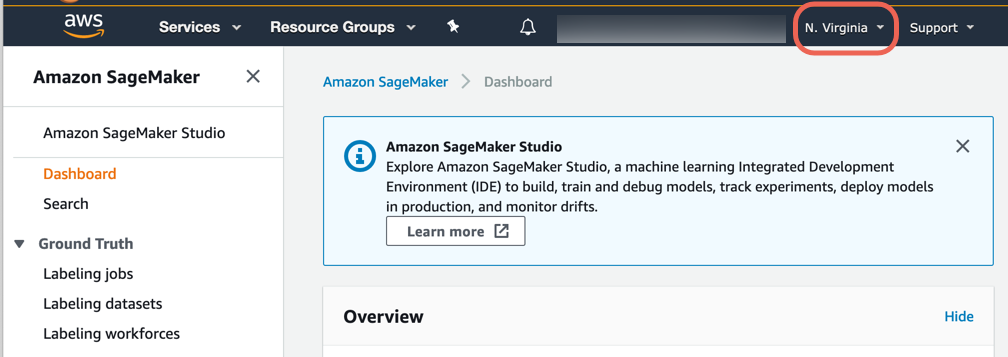
b. In the Amazon SageMaker navigation pane, choose Amazon SageMaker Studio.
Annotation: If you are using Amazon SageMaker Studio for the first time, you lot must complete the Studio onboarding process. When onboarding, you can choose to use either AWS Single Sign-On (AWS SSO) or AWS Identity and Access Management (IAM) for authentication methods. When you utilise IAM authentication, you tin can choose either the Quick start or the Standard setup procedure. If you are unsure of which pick to choose, encounter Onboard to Amazon SageMaker Studio and ask your It ambassador for assistance. For simplicity, this tutorial uses the Quick start process.
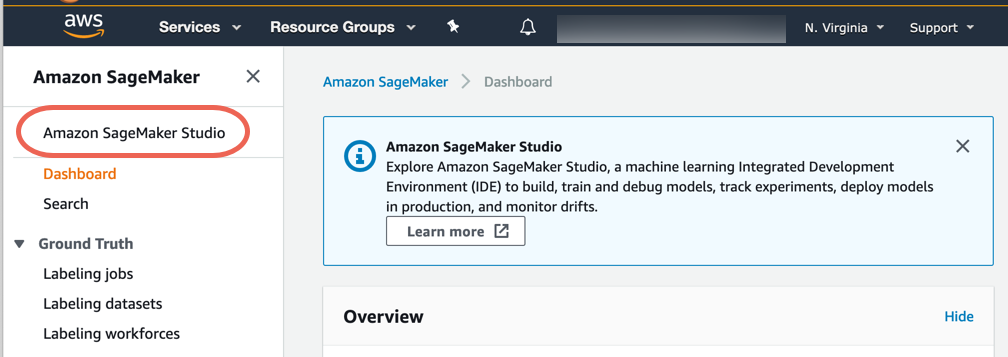
c. In the Get started box, choose Quick starting time and specify a user name.
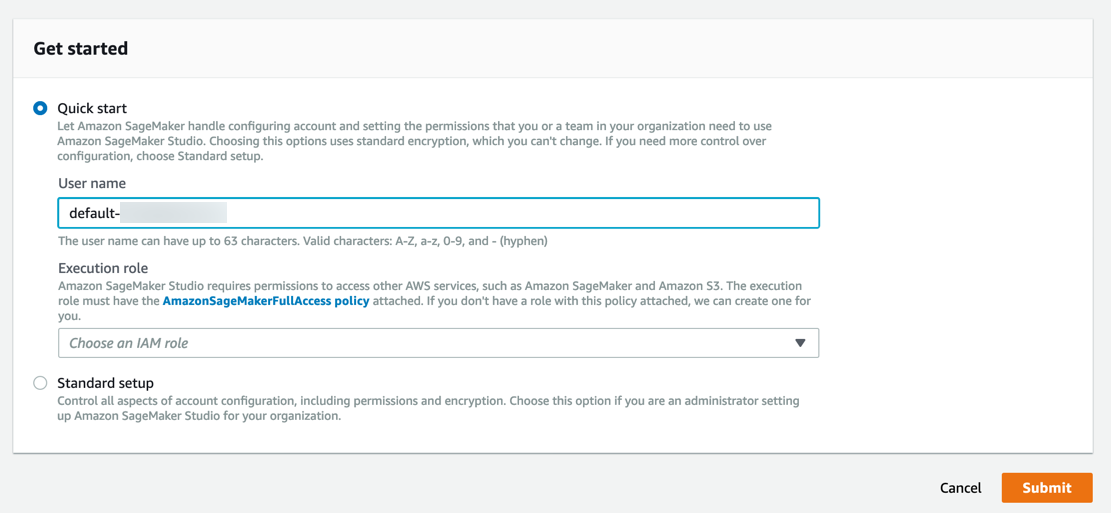
d. For Execution role, choose Create an IAM role. In the dialog box that appears, cull Any S3 saucepan and choose Create role.
Amazon SageMaker creates a role with the required permissions and assigns it to your instance.
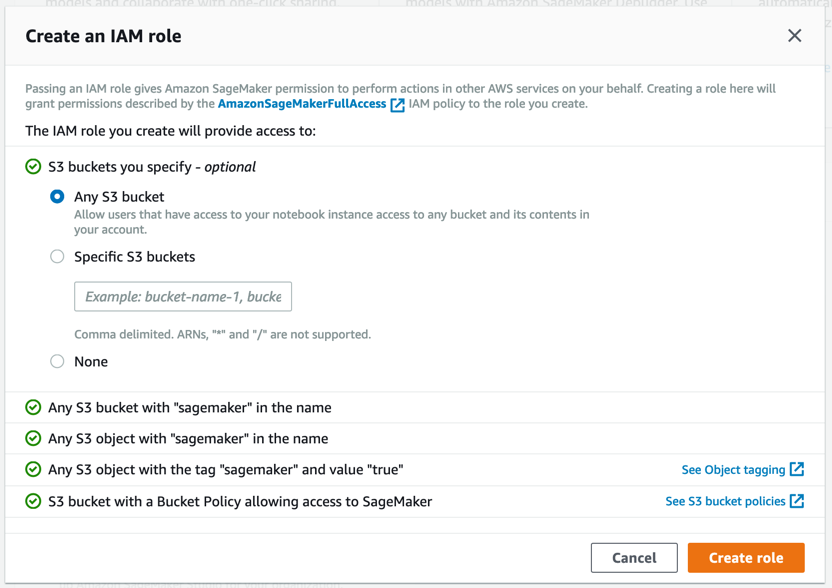

Step 3. Download the dataset
Amazon SageMaker Studio notebooks are one-click Jupyter notebooks that incorporate everything y'all need to build and test your preparation scripts. SageMaker Studio as well includes experiment tracking and visualization so that information technology's easy to manage your entire automobile learning workflow in one place.
Consummate the following steps to create a SageMaker Notebook, download the dataset, and then upload the dataset to Amazon S3.
Note: For more than information, see Use Amazon SageMaker Studio Notebooks in the Amazon SageMaker documentation.
a. In the Amazon SageMaker Studio Control Panel, cull Open Studio.

b. In JupyterLab, on the File carte du jour, choose New, so Notebook. In the Select Kernel box, choose Python 3 (Information Science).
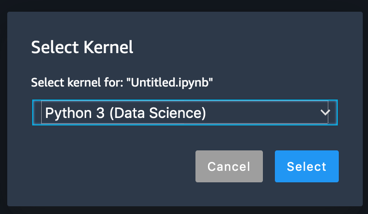
c. Get-go, verify your version of the Amazon SageMaker Python SDK. Re-create and paste the following code block into the code jail cell and select Run.
Note: While the lawmaking runs, an * appears between the square brackets. After a few seconds, the code execution completes and the * is replaced with a number.
import boto3 import sagemaker from sagemaker import get_execution_role import sys import IPython if int(sagemaker.__version__.dissever('.')[0]) == ii: print("Installing previous SageMaker Version and restarting the kernel") !{sys.executable} -yard pip install sagemaker==one.72.0 IPython.Application.instance().kernel.do_shutdown(True) else: print("Version is good") office = get_execution_role() sess = sagemaker.Session() region = boto3.session.Session().region_name print("Region = {}".format(region)) sm = boto3.Session().client('sagemaker') 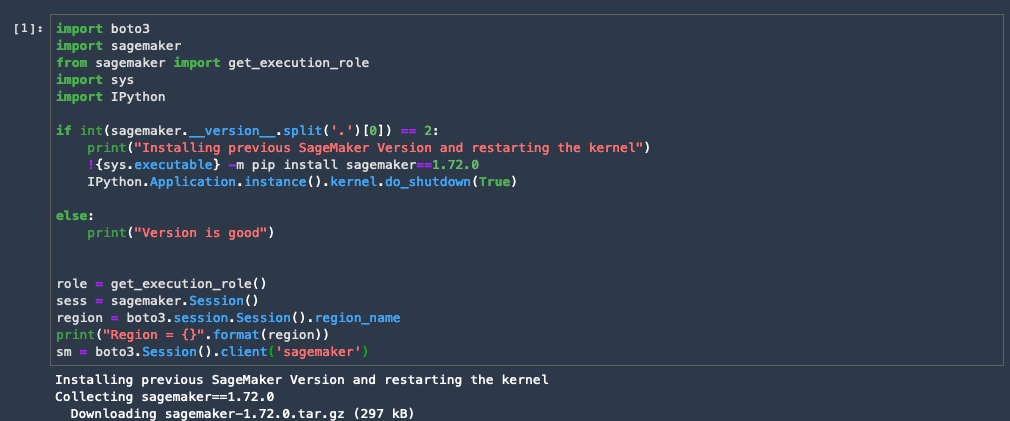
Next, import libraries. Copy and paste the following code into the code cell and select Run.
import matplotlib.pyplot as plt import numpy as np import pandas as pd import os from time import sleep, gmtime, strftime import json import fourth dimension Finally, import the experiments. Re-create and paste the post-obit code into the code cell and select Run.
!pip install sagemaker-experiments from sagemaker.analytics import ExperimentAnalytics from smexperiments.experiment import Experiment from smexperiments.trial import Trial from smexperiments.trial_component import TrialComponent from smexperiments.tracker import Tracker 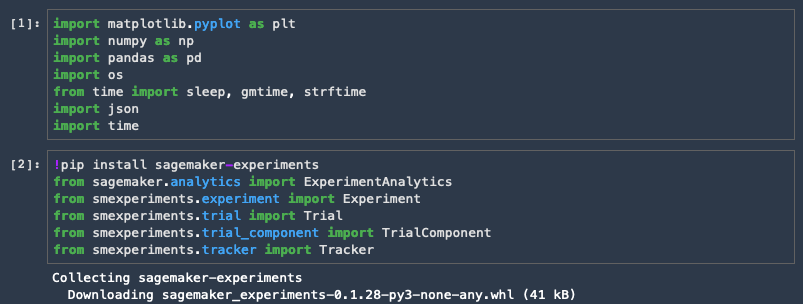
d. Ascertain the Amazon S3 buckets and folders for the project. Re-create and paste the following code into the code jail cell and select Run.
rawbucket= sess.default_bucket() # Alternatively you can utilise our custom bucket hither. prefix = 'sagemaker-modelmonitor' # use this prefix to store all files pertaining to this workshop. dataprefix = prefix + '/data' traindataprefix = prefix + '/train_data' testdataprefix = prefix + '/test_data' testdatanolabelprefix = prefix + '/test_data_no_label' trainheaderprefix = prefix + '/train_headers' 
east. Download the dataset and import it using the pandas library. Re-create and paste the post-obit code into a new lawmaking cell and choose Run.
! wget https://annal.ics.uci.edu/ml/machine-learning-databases/00350/default%20of%20credit%20card%20clients.xls data = pd.read_excel('default of credit card clients.xls', header=1) data = data.drop(columns = ['ID']) information.head() 
f. Rename the concluding column as Label and extract the characterization column separately. For the Amazon SageMaker congenital-in XGBoost algorithm, the label column must exist the beginning cavalcade in the dataframe. To make that change, re-create and paste the following code into a new code prison cell and choose Run.
information.rename(columns={"default payment next calendar month": "Label"}, inplace=Truthful) lbl = data.Label data = pd.concat([lbl, data.drop(columns=['Label'])], axis = i) data.head() 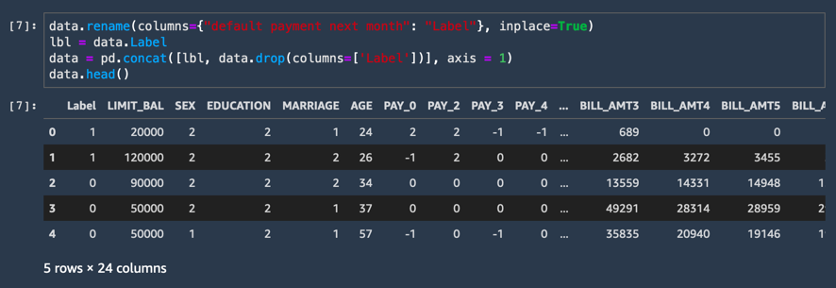
1000. Upload the CSV dataset into an Amazon S3 bucket. Copy and paste the following code into a new lawmaking prison cell and choose Run.
if not os.path.exists('rawdata/rawdata.csv'): !mkdir rawdata data.to_csv('rawdata/rawdata.csv', index=None) else: pass # Upload the raw dataset raw_data_location = sess.upload_data('rawdata', saucepan=rawbucket, key_prefix=dataprefix) print(raw_data_location) You lot're done! The code output displays the S3 bucket URI similar the post-obit example:
s3://sagemaker-us-east-2-ACCOUNT_NUMBER/sagemaker-modelmonitor/information 
Pace 4: Procedure the data using Amazon SageMaker Processing
In this step, you utilize Amazon SageMaker Processing to pre-procedure the dataset, including scaling the columns and splitting the dataset into train and test data. Amazon SageMaker Processing lets you run your preprocessing, postprocessing, and model evaluation workloads on fully managed infrastructure.
Complete the post-obit steps to processs the data and generate features using Amazon SageMaker Processing.
Note: Amazon SageMaker Processing runs on separate compute instances from your notebook. This means you tin can continue to experiment and run code in your notebook while the processing chore is under manner. This will incur additional charges for the cost of the instance which is up and running for the duration of the processing task. The instances are automatically terminated by SageMaker once the processing job completes. For pricing details, see Amazon SageMaker Pricing.
Note: For more than information, see Process Information and Evaluate Models in the Amazon SageMaker documentation.
from sagemaker.sklearn.processing import SKLearnProcessor sklearn_processor = SKLearnProcessor(framework_version='0.20.0', role=role, instance_type='ml.c4.xlarge', instance_count=1) 
b. Re-create and paste the following pre-processing script into a new cell and cull Run.
%%writefile preprocessing.py import argparse import bone import warnings import pandas as pd import numpy every bit np from sklearn.model_selection import train_test_split from sklearn.preprocessing import StandardScaler, MinMaxScaler from sklearn.exceptions import DataConversionWarning from sklearn.compose import make_column_transformer warnings.filterwarnings(activeness='ignore', category=DataConversionWarning) if __name__=='__main__': parser = argparse.ArgumentParser() parser.add_argument('--train-examination-split-ratio', type=float, default=0.3) parser.add_argument('--random-split', blazon=int, default=0) args, _ = parser.parse_known_args() print('Received arguments {}'.format(args)) input_data_path = os.path.join('/opt/ml/processing/input', 'rawdata.csv') print('Reading input data from {}'.format(input_data_path)) df = pd.read_csv(input_data_path) df.sample(frac=1) COLS = df.columns newcolorder = ['PAY_AMT1','BILL_AMT1'] + list(COLS[one:])[:xi] + listing(COLS[1:])[12:17] + list(COLS[ane:])[18:] split_ratio = args.train_test_split_ratio random_state=args.random_split X_train, X_test, y_train, y_test = train_test_split(df.drib('Characterization', centrality=1), df['Label'], test_size=split_ratio, random_state=random_state) preprocess = make_column_transformer( (['PAY_AMT1'], StandardScaler()), (['BILL_AMT1'], MinMaxScaler()), remainder='passthrough') print('Running preprocessing and feature engineering transformations') train_features = pd.DataFrame(preprocess.fit_transform(X_train), columns = newcolorder) test_features = pd.DataFrame(preprocess.transform(X_test), columns = newcolorder) # concat to ensure Characterization column is the first column in dataframe train_full = pd.concat([pd.DataFrame(y_train.values, columns=['Label']), train_features], axis=1) test_full = pd.concat([pd.DataFrame(y_test.values, columns=['Label']), test_features], axis=1) print('Railroad train data shape later preprocessing: {}'.format(train_features.shape)) print('Test data shape after preprocessing: {}'.format(test_features.shape)) train_features_headers_output_path = os.path.join('/opt/ml/processing/train_headers', 'train_data_with_headers.csv') train_features_output_path = os.path.join('/opt/ml/processing/train', 'train_data.csv') test_features_output_path = os.path.join('/opt/ml/processing/exam', 'test_data.csv') print('Saving training features to {}'.format(train_features_output_path)) train_full.to_csv(train_features_output_path, header=False, alphabetize=False) impress("Complete") print("Save training information with headers to {}".format(train_features_headers_output_path)) train_full.to_csv(train_features_headers_output_path, alphabetize=False) print('Saving exam features to {}'.format(test_features_output_path)) test_full.to_csv(test_features_output_path, header=Fake, index=False) print("Complete") c. Re-create the preprocessing code over to the Amazon S3 bucket using the post-obit lawmaking, then choose Run.
# Copy the preprocessing code over to the s3 bucket codeprefix = prefix + '/code' codeupload = sess.upload_data('preprocessing.py', bucket=rawbucket, key_prefix=codeprefix) impress(codeupload) 
d. Specify where you want to store your training and test data later the SageMaker Processing chore completes. Amazon SageMaker Processing automatically stores the information in the specified location.
train_data_location = rawbucket + '/' + traindataprefix test_data_location = rawbucket+'/'+testdataprefix print("Grooming data location = {}".format(train_data_location)) print("Examination data location = {}".format(test_data_location)) 
e. Copy and paste the post-obit lawmaking to start the Processing job. This lawmaking starts the job by calling sklearn_processor.run and extracts some optional metadata about the processing job, such as where the training and test outputs were stored.
from sagemaker.processing import ProcessingInput, ProcessingOutput sklearn_processor.run(code=codeupload, inputs=[ProcessingInput( source=raw_data_location, destination='/opt/ml/processing/input')], outputs=[ProcessingOutput(output_name='train_data', source='/opt/ml/processing/train', destination='s3://' + train_data_location), ProcessingOutput(output_name='test_data', source='/opt/ml/processing/test', destination="s3://"+test_data_location), ProcessingOutput(output_name='train_data_headers', source='/opt/ml/processing/train_headers', destination="s3://" + rawbucket + '/' + prefix + '/train_headers')], arguments=['--train-test-split-ratio', '0.2'] ) preprocessing_job_description = sklearn_processor.jobs[-i].depict() output_config = preprocessing_job_description['ProcessingOutputConfig'] for output in output_config['Outputs']: if output['OutputName'] == 'train_data': preprocessed_training_data = output['S3Output']['S3Uri'] if output['OutputName'] == 'test_data': preprocessed_test_data = output['S3Output']['S3Uri'] Notation the locations of the code, railroad train and examination data in the outputs provided to the processor. Also, annotation the arguments provided to the processing scripts.
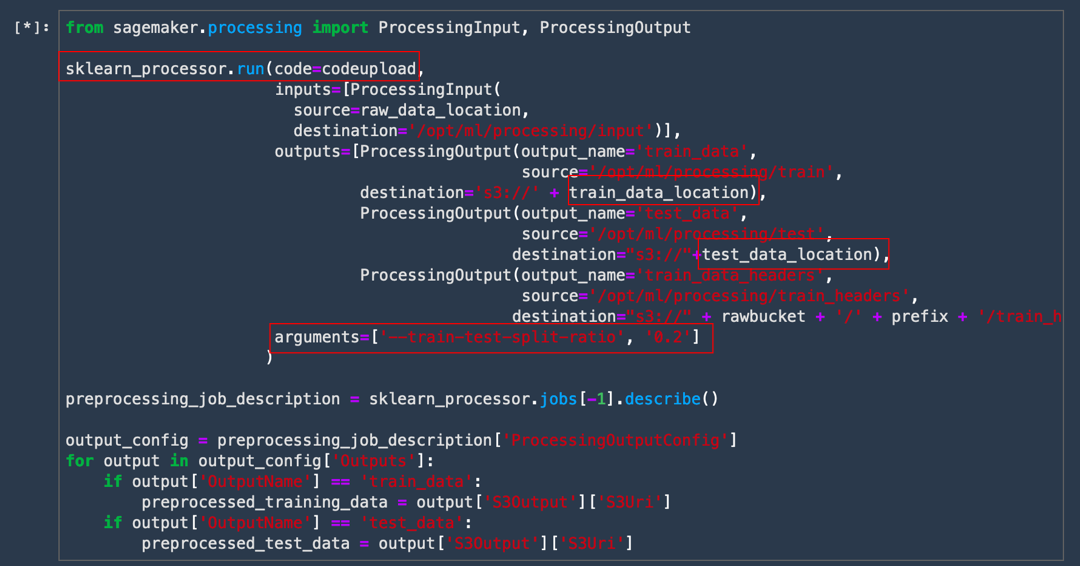
Step 5: Create an Amazon SageMaker Experiment
Now that you have downloaded and staged your dataset in Amazon S3, yous can create an Amazon SageMaker Experiment. An experiment is a collection of processing and training jobs related to the same machine learning project. Amazon SageMaker Experiments automatically manages and tracks your grooming runs for you.
Complete the following steps to create a new experiment.
Note: For more data, see Experiments in the Amazon SageMaker documentation.
a. Copy and paste the following code to create an experiment named Build-train-deploy-.
# Create a SageMaker Experiment cc_experiment = Experiment.create( experiment_name=f"Build-train-deploy-{int(time.time())}", description="Predict credit card default from payments data", sagemaker_boto_client=sm) print(cc_experiment) Every training task is logged as a trial. Each trial is an iteration of your end-to-end training job. In addition to the training task, it can too track pre-processing and post-processing jobs as well as datasets and other metadata. A single experiment can include multiple trials which makes information technology easy for you lot to track multiple iterations over time within the Amazon SageMaker Studio Experiments pane.
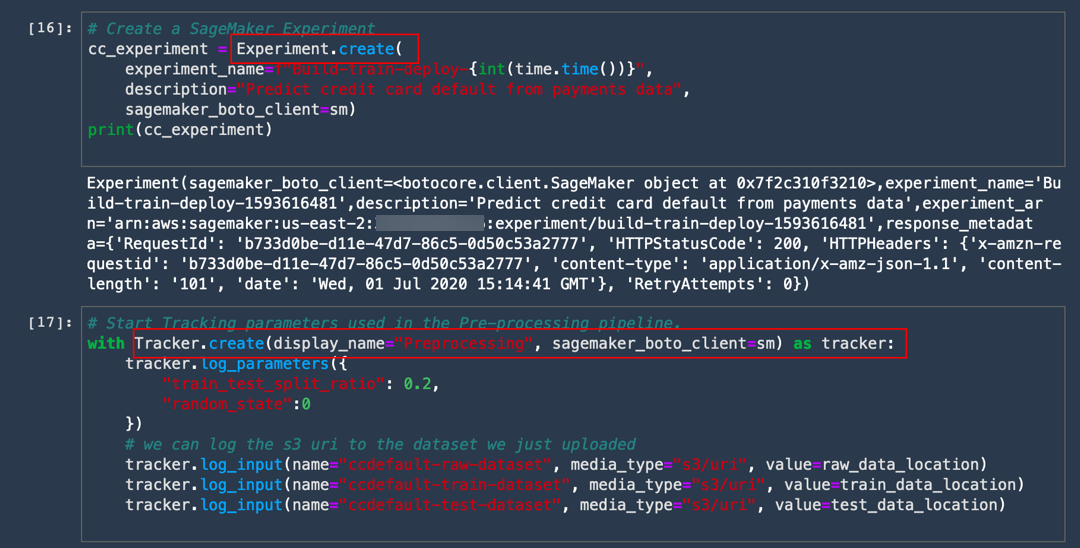
b. Copy and paste the following code to track your pre-processing task under Experiments besides as a footstep in the training pipeline.
# Showtime Tracking parameters used in the Pre-processing pipeline. with Tracker.create(display_name="Preprocessing", sagemaker_boto_client=sm) as tracker: tracker.log_parameters({ "train_test_split_ratio": 0.two, "random_state":0 }) # nosotros can log the s3 uri to the dataset we just uploaded tracker.log_input(name="ccdefault-raw-dataset", media_type="s3/uri", value=raw_data_location) tracker.log_input(proper noun="ccdefault-train-dataset", media_type="s3/uri", value=train_data_location) tracker.log_input(name="ccdefault-examination-dataset", media_type="s3/uri", value=test_data_location) c. View the details of the experiment: In the Experiments pane, right-click the experiment named Build-train-deploy- and choose Open up in trial components list.

d. Copy and paste the following lawmaking and choose Run. Then, take a closer expect at the code:
To train an XGBoost classifier, you first import the XGBoost container maintained past Amazon SageMaker. Then, you log the training run under a Trial and then SageMaker Experiments can runway it under a Trial name. The pre-processing job is included under the aforementioned trial name since it is part of the pipeline. Adjacent, create a SageMaker Figurer object, which automatically provisions the underlying instance type of your choosing, copies over the training data from the specified output location from the processing job, trains the model, and outputs the model artifacts.
from sagemaker.amazon.amazon_estimator import get_image_uri container = get_image_uri(boto3.Session().region_name, 'xgboost', '1.0-1') s3_input_train = sagemaker.s3_input(s3_data='s3://' + train_data_location, content_type='csv') preprocessing_trial_component = tracker.trial_component trial_name = f"cc-default-grooming-task-{int(fourth dimension.time())}" cc_trial = Trial.create( trial_name=trial_name, experiment_name=cc_experiment.experiment_name, sagemaker_boto_client=sm ) cc_trial.add_trial_component(preprocessing_trial_component) cc_training_job_name = "cc-training-job-{}".format(int(time.fourth dimension())) xgb = sagemaker.estimator.Calculator(container, role, train_instance_count=1, train_instance_type='ml.m4.xlarge', train_max_run=86400, output_path='s3://{}/{}/models'.format(rawbucket, prefix), sagemaker_session=sess) # ready to truthful for distributed training xgb.set_hyperparameters(max_depth=v, eta=0.2, gamma=4, min_child_weight=6, subsample=0.8, verbosity=0, objective='binary:logistic', num_round=100) xgb.fit(inputs = {'train':s3_input_train}, job_name=cc_training_job_name, experiment_config={ "TrialName": cc_trial.trial_name, #log preparation job in Trials for lineage "TrialComponentDisplayName": "Grooming", }, look=True, ) time.slumber(2) The training job will take well-nigh 70 seconds to consummate. You should see the following output.
Completed - Training job completed 
e. In the left toolbar, choose Experiment. Right-click the Build-railroad train-deploy- experiment and choose Open in trial components list. Amazon SageMaker Experiments captures all the runs including whatsoever failed grooming runs.
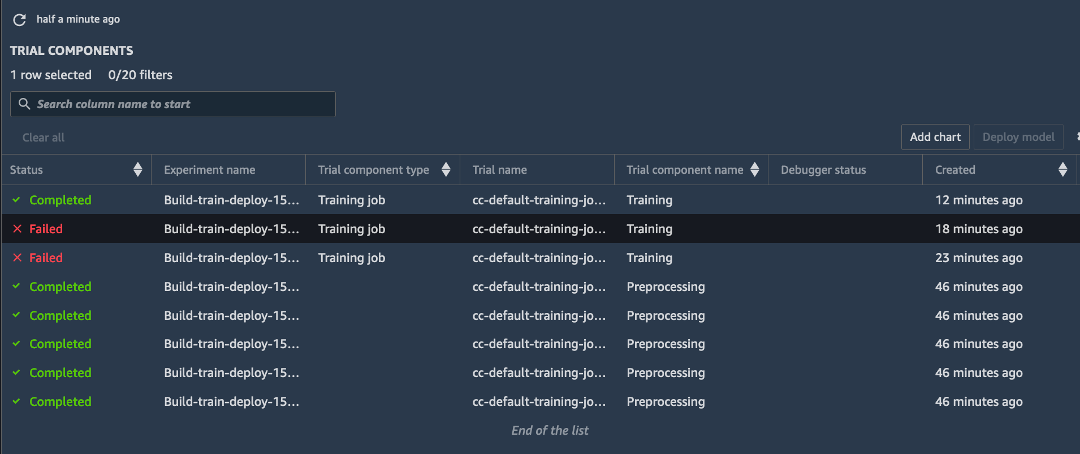
f. Right-click one of the completed Training jobs and choose Open in Trial Details to explore the associated metadata with the training task.
Note: You may need to refresh the page to see the latest results.
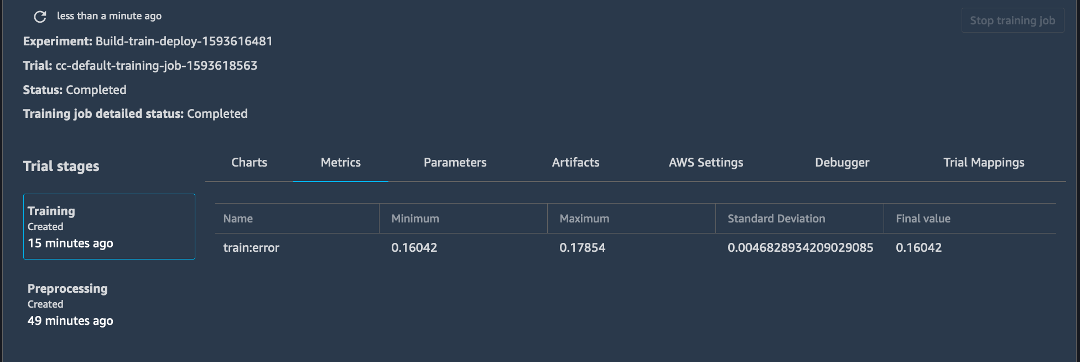
Step half-dozen: Deploy the model for offline inference
In your preprocessing step, you lot generated some exam data. In this pace, you lot generate offline or batch inference from the trained model to evaluate the model performance on unseen test data.
Complete the post-obit steps to deploy the model for offline inference.
Notation: For more data, meet Batch Transform in the Amazon SageMaker documentation.
a. Copy and paste the post-obit code and choose Run.
This step copies the test dataset over from the Amazon S3 location into your local folder.
test_data_path = 's3://' + test_data_location + '/test_data.csv' ! aws s3 cp $test_data_path . 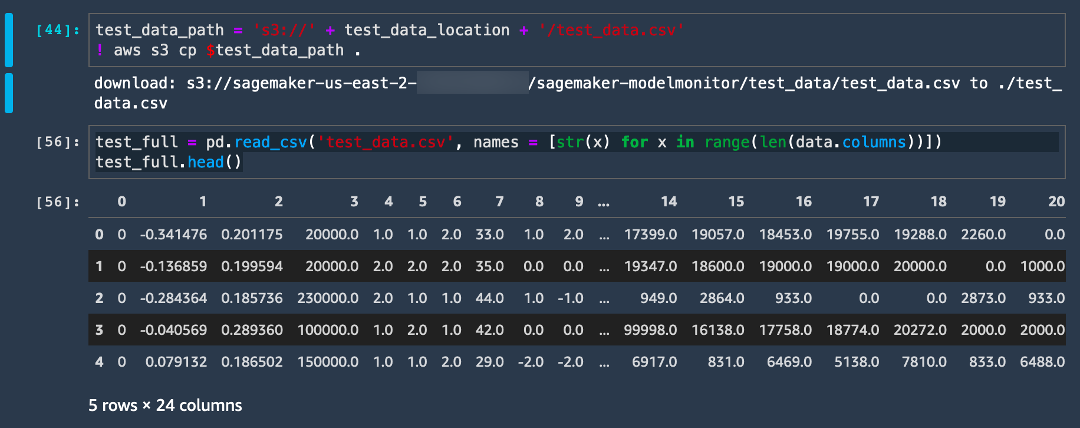
b. Re-create and paste the post-obit lawmaking and choose Run.
test_full = pd.read_csv('test_data.csv', names = [str(x) for x in range(len(data.columns))]) test_full.head() c. Copy and paste the following code and choose Run. This step extracts the label column.
d. Re-create and paste the following code and cull Run to create the Batch Transform job. Then, take a closer look at the lawmaking:
Similar the training job, SageMaker provisions all the underlying resources, copies over the trained model artifacts, sets upwards a Batch endpoint locally, copies over the information, and runs inferences on the data and pushes the outputs to Amazon S3. Note that by setting the input_filter, you are letting Batch Transform know to neglect the first column in the exam data which is the label cavalcade.
%%time sm_transformer = xgb.transformer(i, 'ml.m5.xlarge', accept = 'text/csv') # first a transform task sm_transformer.transform(test_data_path, split_type='Line', input_filter='$[1:]', content_type='text/csv') sm_transformer.wait() The Batch Transform job will have almost 4 minutes to complete afterwards which yous can evaluate the model results.

due east. Copy and run the following code to evaluate the model metrics. And so, take a closer look at the code:
Offset, y'all define a office that pulls the output of the Batch Transform job, which is independent in a file with a .out extension from the Amazon S3 bucket. Then, you excerpt the predicted labels into a dataframe and suspend the true labels to this dataframe.
import json import io from urllib.parse import urlparse def get_csv_output_from_s3(s3uri, file_name): parsed_url = urlparse(s3uri) bucket_name = parsed_url.netloc prefix = parsed_url.path[1:] s3 = boto3.resources('s3') obj = s3.Object(bucket_name, '{}/{}'.format(prefix, file_name)) return obj.get()["Body"].read().decode('utf-viii') output = get_csv_output_from_s3(sm_transformer.output_path, 'test_data.csv.out') output_df = pd.read_csv(io.StringIO(output), sep=",", header=None) output_df.head(8) output_df['Predicted']=np.round(output_df.values) output_df['Label'] = label from sklearn.metrics import confusion_matrix, accuracy_score confusion_matrix = pd.crosstab(output_df['Predicted'], output_df['Label'], rownames=['Actual'], colnames=['Predicted'], margins = True) confusion_matrix You should see an output similar to the image, which shows the total number of Predicted True and Imitation values compared to the Actual values.
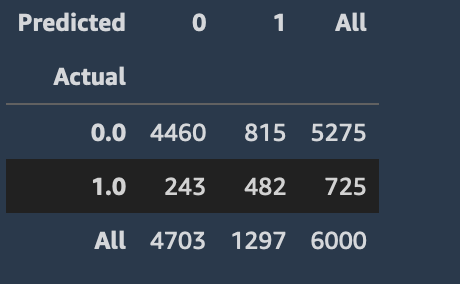
f. Use the following lawmaking to extract both the baseline model accuracy and the model accuracy.
Note: A helpful model for the baseline accuracy can be the fraction of non-default cases. A model that e'er predicts that a user will not default has that accuracy.
print("Baseline Accuracy = {}".format(1- np.unique(data['Label'], return_counts=True)[1][1]/(len(data['Label'])))) print("Accurateness Score = {}".format(accuracy_score(characterization, output_df['Predicted']))) The results testify that a simple model tin already beat the baseline accuracy. In club to amend the results, yous can tune the hyperparameters. You can utilise hyperparameter optimization (HPO) on SageMaker for automatic model tuning. To learn more, run into How Hyperparameter Tuning Works.
Note: Although it is not included in this tutorial, y'all also have the option of including Batch Transform as office of your trial. When you call the .transform function, simply pass in the experiment_config as you did for the Preparation chore. Amazon SageMaker automatically associates the Batch Transform equally a trial component.

Pace 7: Deploy the model every bit an endpoint and set up information capture
In this step, you deploy the model as a RESTful HTTPS endpoint to serve live inferences. Amazon SageMaker automatically handles the model hosting and creation of the endpoint for you.
Complete the post-obit steps to deploy the model equally an endpoint and set up data capture.
Note: For more than information, run across Deploy Models for Inference in the Amazon SageMaker documentation.
a. Re-create and paste the following lawmaking and cull Run.
from sagemaker.model_monitor import DataCaptureConfig from sagemaker import RealTimePredictor from sagemaker.predictor import csv_serializer sm_client = boto3.client('sagemaker') latest_training_job = sm_client.list_training_jobs(MaxResults=ane, SortBy='CreationTime', SortOrder='Descending') training_job_name=TrainingJobName=latest_training_job['TrainingJobSummaries'][0]['TrainingJobName'] training_job_description = sm_client.describe_training_job(TrainingJobName=training_job_name) model_data = training_job_description['ModelArtifacts']['S3ModelArtifacts'] container_uri = training_job_description['AlgorithmSpecification']['TrainingImage'] # create a model. def create_model(role, model_name, container_uri, model_data): render sm_client.create_model( ModelName=model_name, PrimaryContainer={ 'Image': container_uri, 'ModelDataUrl': model_data, }, ExecutionRoleArn=function) try: model = create_model(role, training_job_name, container_uri, model_data) except Exception as e: sm_client.delete_model(ModelName=training_job_name) model = create_model(role, training_job_name, container_uri, model_data) print('Model created: '+model['ModelArn']) 
b. To specify the data configuration settings, copy and paste the following code and choose Run.
This code tells SageMaker to capture 100% of the inference payloads received by the endpoint, capture both inputs and outputs, and also note the input content type every bit csv.
s3_capture_upload_path = 's3://{}/{}/monitoring/datacapture'.format(rawbucket, prefix) data_capture_configuration = { "EnableCapture": True, "InitialSamplingPercentage": 100, "DestinationS3Uri": s3_capture_upload_path, "CaptureOptions": [ { "CaptureMode": "Output" }, { "CaptureMode": "Input" } ], "CaptureContentTypeHeader": { "CsvContentTypes": ["text/csv"], "JsonContentTypes": ["awarding/json"]}} c. Copy and paste the following code and choose Run. This footstep creates an endpoint configuration and deploys the endpoint. In the code, you can specify instance type and whether you want to send all the traffic to this endpoint, etc.
def create_endpoint_config(model_config, data_capture_config): return sm_client.create_endpoint_config( EndpointConfigName=model_config, ProductionVariants=[ { 'VariantName': 'AllTraffic', 'ModelName': model_config, 'InitialInstanceCount': 1, 'InstanceType': 'ml.m4.xlarge', 'InitialVariantWeight': 1.0, }, ], DataCaptureConfig=data_capture_config ) try: endpoint_config = create_endpoint_config(training_job_name, data_capture_configuration) except Exception as e: sm_client.delete_endpoint_config(EndpointConfigName=endpoint) endpoint_config = create_endpoint_config(training_job_name, data_capture_configuration) print('Endpoint configuration created: '+ endpoint_config['EndpointConfigArn']) d. Re-create and paste the following lawmaking and choose Run to create the endpoint.
# Enable data capture, sampling 100% of the information for at present. Next we deploy the endpoint in the correct VPC. endpoint_name = training_job_name def create_endpoint(endpoint_name, config_name): return sm_client.create_endpoint( EndpointName=endpoint_name, EndpointConfigName=training_job_name ) try: endpoint = create_endpoint(endpoint_name, endpoint_config) except Exception as e: sm_client.delete_endpoint(EndpointName=endpoint_name) endpoint = create_endpoint(endpoint_name, endpoint_config) print('Endpoint created: '+ endpoint['EndpointArn']) 
e. In the left toolbar, choose Endpoints. The Endpoints list displays all of the endpoints in service.
Notice the build-train-deploy endpoint shows a status of Creating. To deploy the model, Amazon SageMaker must commencement copy your model artifacts and inference image onto the instance and set up a HTTPS endpoint to inferface with customer applications or RESTful APIs.

Once the endpoint is created, the status changes to InService. (Note that creating an endpoint may take about 5-10 minutes.)
Annotation: You may need to click Refresh to go the updated condition.

f. In the JupyterLab Notebook, re-create and run the following code to accept a sample of the test dataset. This lawmaking takes the offset 10 rows.
!head -10 test_data.csv > test_sample.csv g. Run the following code to send some inference requests to this endpoint.
Note: If you specified a different endpoint name, you will need to supersede endpoint below with your endpoint name.
from sagemaker import RealTimePredictor from sagemaker.predictor import csv_serializer predictor = RealTimePredictor(endpoint=endpoint_name, content_type = 'text/csv') with open up('test_sample.csv', 'r') as f: for row in f: payload = row.rstrip('\due north') response = predictor.predict(data=payload[2:]) sleep(0.5) print('done!') h. Run the following code to verify that Model Monitor is correctly capturing the incoming data.
In the code, the current_endpoint_capture_prefix captures the directory path where your ModelMonitor outputs are stored. Navigate to your Amazon S3 bucket, to see if the prediction requests are beingness captured. Note that this location should match the s3_capture_upload_path in the lawmaking above.
# Extract the captured json files. data_capture_prefix = '{}/monitoring'.format(prefix) s3_client = boto3.Session().client('s3') current_endpoint_capture_prefix = '{}/datacapture/{}/AllTraffic'.format(data_capture_prefix, endpoint_name) impress(current_endpoint_capture_prefix) result = s3_client.list_objects(Bucket=rawbucket, Prefix=current_endpoint_capture_prefix) capture_files = [capture_file.go("Key") for capture_file in issue.get('Contents')] impress("Found Capture Files:") impress("\n ".bring together(capture_files)) capture_files[0] The captured output indicates that data capture is configured and saving the incoming requests.
Annotation: If you lot initially encounter a Nix response, the information may not have been synchronously loaded onto the Amazon S3 path when you first initialized the data capture. Await about a infinitesimal and try again.
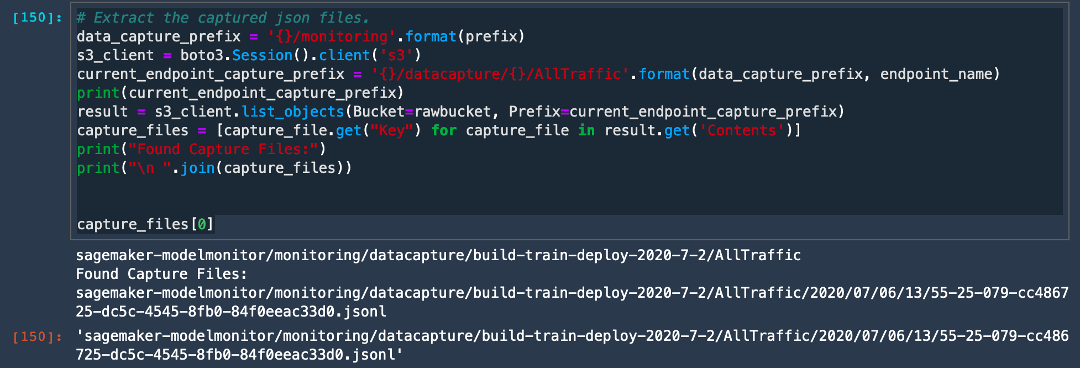
i. Run the post-obit code to extract the content of one of the json files and view the captured outputs.
# View contents of the captured file. def get_obj_body(bucket, obj_key): return s3_client.get_object(Bucket=rawbucket, Primal=obj_key).go('Torso').read().decode("utf-8") capture_file = get_obj_body(rawbucket, capture_files[0]) print(json.dumps(json.loads(capture_file.split('\north')[v]), indent = ii, sort_keys =True)) The output indicates that data capture is capturing both the input payload and the output of the model.
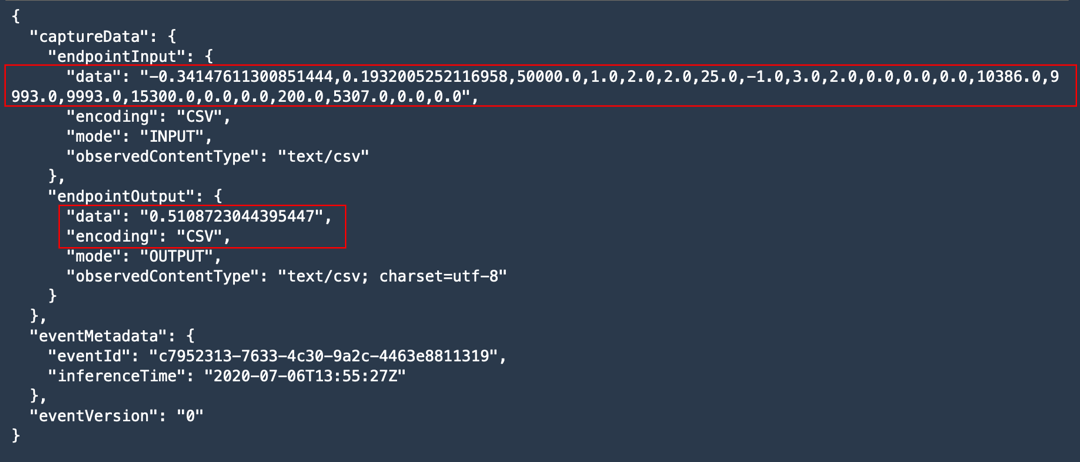
Step 8: Monitor the endpoint with SageMaker Model Monitor
In this step, you lot enable SageMaker Model Monitor to monitor the deployed endpoint for data migrate. To do then, you compare the payload and outputs sent to the model against a baseline and determine whether there is whatsoever migrate in the input data, or the characterization.
Complete the following steps to enable model monitoring.
Note: For more than data, see Amazon SageMaker Model Monitor in the Amazon SageMaker documentation.
a. Run the following lawmaking to create a folder in your Amazon S3 saucepan to store the outputs of the Model Monitor.
This code creates two folders: ane folder stores the baseline data which you used for training your model; the second binder stores any violations from that baseline.
model_prefix = prefix + "/" + endpoint_name baseline_prefix = model_prefix + '/baselining' baseline_data_prefix = baseline_prefix + '/data' baseline_results_prefix = baseline_prefix + '/results' baseline_data_uri = 's3://{}/{}'.format(rawbucket,baseline_data_prefix) baseline_results_uri = 's3://{}/{}'.format(rawbucket, baseline_results_prefix) train_data_header_location = "s3://" + rawbucket + '/' + prefix + '/train_headers' print('Baseline data uri: {}'.format(baseline_data_uri)) print('Baseline results uri: {}'.format(baseline_results_uri)) print(train_data_header_location) 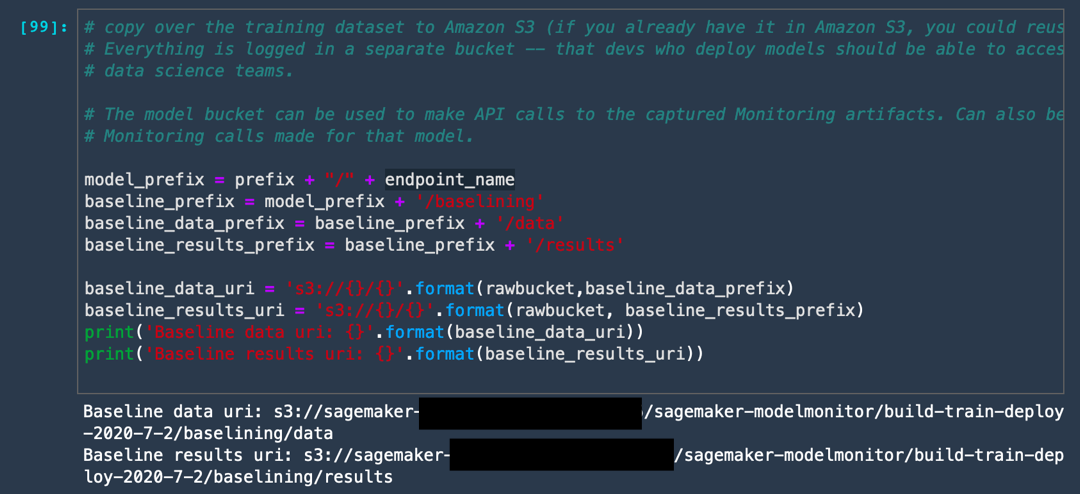
b. Run the following code to ready up a baseline job for Model Monitor to capture the statistics of the preparation data. To practice this, Model Monitor uses the deequ library built on acme of Apache Spark for conducting unit tests on data.
from sagemaker.model_monitor import DefaultModelMonitor from sagemaker.model_monitor.dataset_format import DatasetFormat my_default_monitor = DefaultModelMonitor( part=role, instance_count=1, instance_type='ml.m5.xlarge', volume_size_in_gb=20, max_runtime_in_seconds=3600) my_default_monitor.suggest_baseline( baseline_dataset=os.path.bring together(train_data_header_location, 'train_data_with_headers.csv'), dataset_format=DatasetFormat.csv(header=True), output_s3_uri=baseline_results_uri, wait=True ) Model Monitor sets upwards a separate instance, copies over the training information, and generates some statistics. The service generates a lot of Apache Spark logs, which you can ignore. Once the job is completed, you will come across a Spark task completed output.
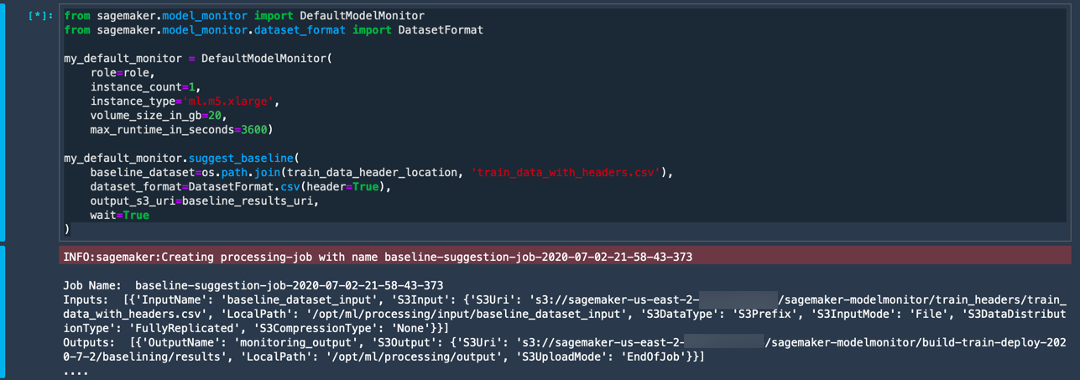
c. Run the following code to look at the outputs generated by the baseline task.
s3_client = boto3.Session().client('s3') result = s3_client.list_objects(Bucket=rawbucket, Prefix=baseline_results_prefix) report_files = [report_file.get("Key") for report_file in result.get('Contents')] print("Found Files:") print("\due north ".join(report_files)) baseline_job = my_default_monitor.latest_baselining_job schema_df = pd.io.json.json_normalize(baseline_job.baseline_statistics().body_dict["features"]) schema_df You volition see 2 files: constraints.json and statistics.json. Next, dive deeper into their contents.

The code higher up converts the json output in /statistics.json into a pandas dataframe. Note how the deequ library infers the data type of the column, the presence or absence of Zip or missing values, and statistical parameters such as the mean, min, max, sum, standard difference, and sketch parameters for an input data stream.
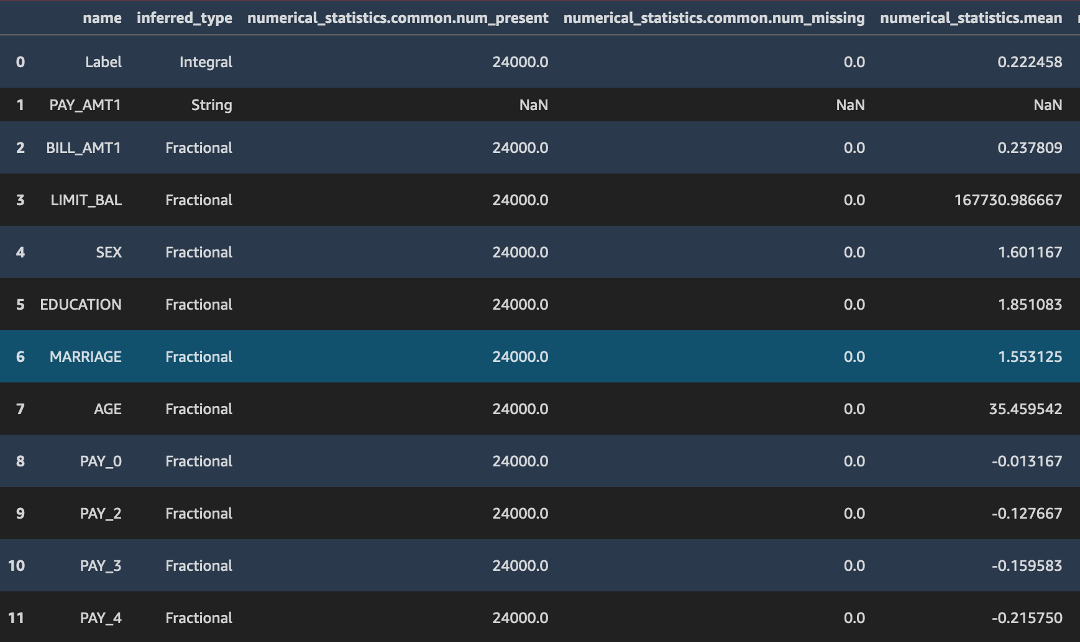
Likewise, the constraints.json file consists of a number of constraints the training dataset obeys such as not-negativity of values, and the information type of the feature field.
constraints_df = pd.io.json.json_normalize(baseline_job.suggested_constraints().body_dict["features"]) constraints_df 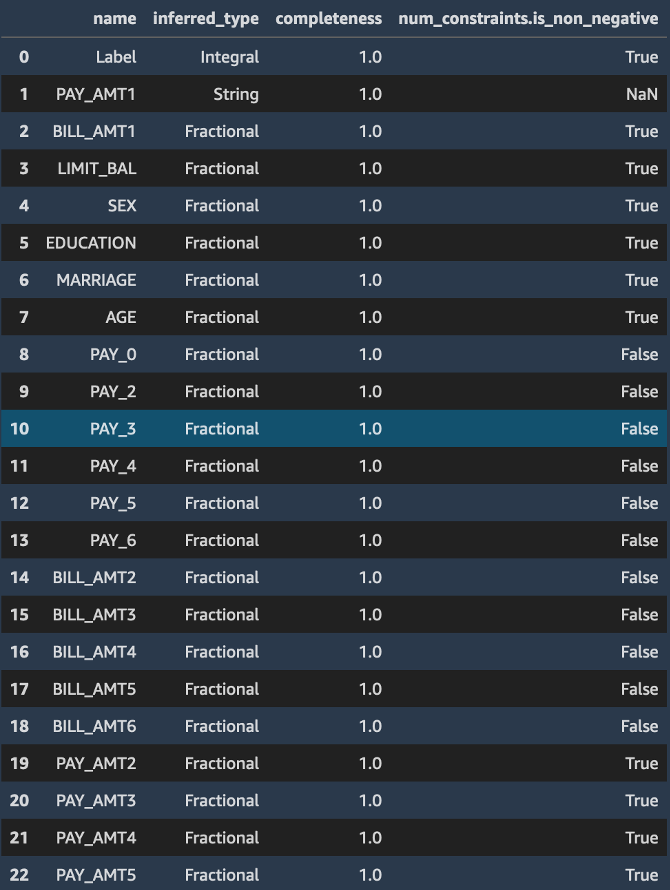
d. Run the following lawmaking to set upwardly the frequency for endpoint monitoring.
You can specify daily or hourly. This code specifies an hourly frequency, simply you may desire to change this for production applications equally hourly frequency will generate a lot of data. Model Monitor will produce a written report consisting of all the violations it finds.
reports_prefix = '{}/reports'.format(prefix) s3_report_path = 's3://{}/{}'.format(rawbucket,reports_prefix) print(s3_report_path) from sagemaker.model_monitor import CronExpressionGenerator from fourth dimension import gmtime, strftime mon_schedule_name = 'Built-railroad train-deploy-model-monitor-schedule-' + strftime("%Y-%m-%d-%H-%M-%Due south", gmtime()) my_default_monitor.create_monitoring_schedule( monitor_schedule_name=mon_schedule_name, endpoint_input=predictor.endpoint, output_s3_uri=s3_report_path, statistics=my_default_monitor.baseline_statistics(), constraints=my_default_monitor.suggested_constraints(), schedule_cron_expression=CronExpressionGenerator.hourly(), enable_cloudwatch_metrics=True, ) Note that this lawmaking enables Amazon CloudWatch Metrics, which instructs Model Monitor to send outputs to CloudWatch. Y'all can employ this approach to trigger alarms using CloudWatch Alarms to allow engineers or admins know when information drift has been detected.

Step 9: Test SageMaker Model Monitor performance
In this step, you lot evaluate Model Monitor confronting some sample information. Instead of sending the test payload as is, you change the distribution of several features in the test payload to test that Model Monitor can observe the change.
Complete the following steps to test the Model Monitor performance.
Note: For more information, see Amazon SageMaker Model Monitor in the Amazon SageMaker documentation.
a. Run the following lawmaking to import the test data and generate some modified sample data.
COLS = data.columns test_full = pd.read_csv('test_data.csv', names = ['Label'] +['PAY_AMT1','BILL_AMT1'] + list(COLS[one:])[:11] + list(COLS[ane:])[12:17] + list(COLS[1:])[18:] ) test_full.head() 
b. Run the post-obit code to change a few columns. Note the differences marked in cherry-red in the image hither from the previous step. Drop the label column and relieve the modified sample test information.
faketestdata = test_full faketestdata['EDUCATION'] = -faketestdata['EDUCATION'].astype(float) faketestdata['BILL_AMT2']= (faketestdata['BILL_AMT2']//10).astype(float) faketestdata['AGE']= (faketestdata['AGE']-ten).astype(float) faketestdata.head() faketestdata.drop(columns=['Characterization']).to_csv('test-data-input-cols.csv', index = None, header=None) 
c. Run the post-obit code to repeatedly invoke the endpoint with this modified dataset.
from threading import Thread runtime_client = boto3.customer('runtime.sagemaker') # (just repeating code from above for convenience/ able to run this section independently) def invoke_endpoint(ep_name, file_name, runtime_client): with open up(file_name, 'r') as f: for row in f: payload = row.rstrip('\due north') response = runtime_client.invoke_endpoint(EndpointName=ep_name, ContentType='text/csv', Trunk=payload) time.sleep(1) def invoke_endpoint_forever(): while True: invoke_endpoint(endpoint, 'test-data-input-cols.csv', runtime_client) thread = Thread(target = invoke_endpoint_forever) thread.starting time() # Notation that yous need to finish the kernel to cease the invocations d. Run the following lawmaking to bank check the condition of the Model Monitor job.
desc_schedule_result = my_default_monitor.describe_schedule() print('Schedule condition: {}'.format(desc_schedule_result['MonitoringScheduleStatus'])) You should see an output of Schedule condition: Scheduled
e. Run the post-obit code to check every 10 minutes if whatsoever monitoring outputs take been generated. Note that the start job may run with a buffer of virtually 20 minutes.
mon_executions = my_default_monitor.list_executions() print("Nosotros created ahourly schedule above and it volition kick off executions ON the hour (plus 0 - twenty min buffer.\nWe will have to wait till nosotros hit the hour...") while len(mon_executions) == 0: print("Waiting for the 1st execution to happen...") time.slumber(600) mon_executions = my_default_monitor.list_executions() 
f. In the left toolbar of Amazon SageMaker Studio, choose Endpoints. Correct-click the build-train-deploy endpoint and choose Describe Endpoint.
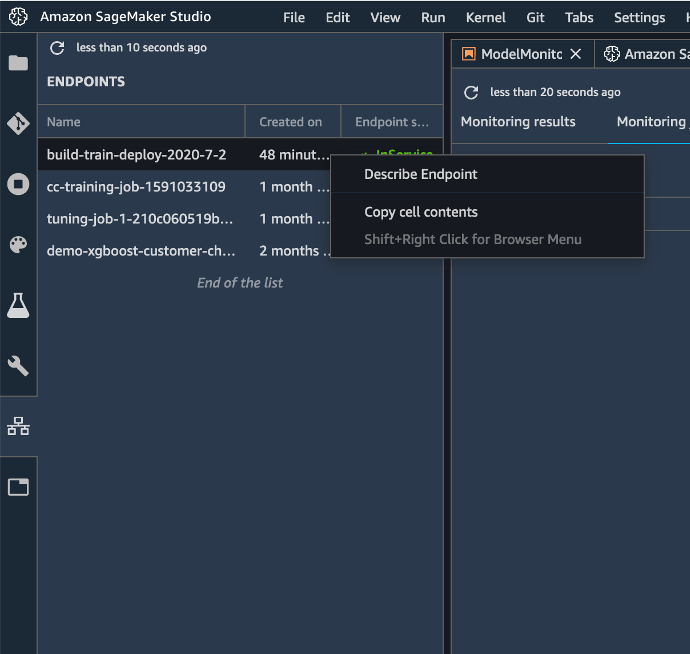
m. Choose Monitoring job history. Notice that the Monitoring status shows In progress.

Once the job is complete, the Monitoring status displays Outcome found (for whatever problems found).

h. Double-click the issue to view details. You can see that Model Monitor detected large baseline drifts in the EDUCATION and BILL_AMT2 fields that yous previously modified.
Model Monitor likewise detected some differences in information types in ii other fields. The preparation data consists of integer labels, only the XGBoost model predicts a probability score. Therefore, Model Monitor reported a mismatch.
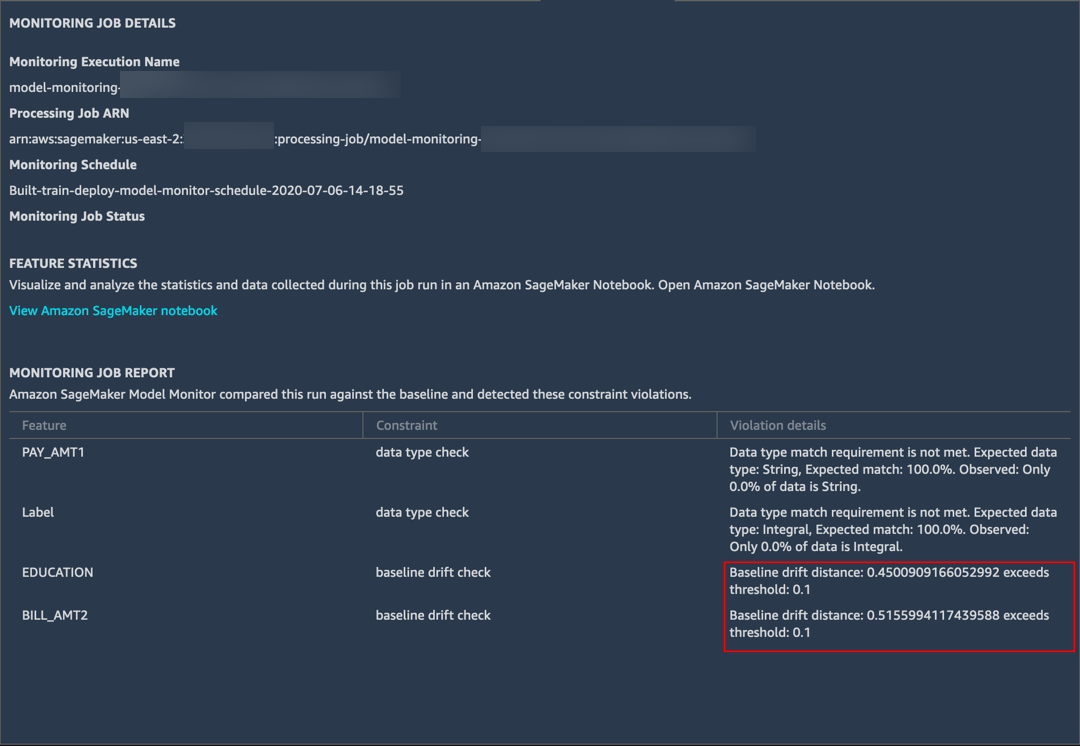
i. In your JupyterLab Notebook, run the following cells to see the output from Model Monitor.
latest_execution = mon_executions[-one] # latest execution'south index is -ane, 2d to last is -2 and so on.. time.sleep(60) latest_execution.await(logs=False) print("Latest execution condition: {}".format(latest_execution.depict()['ProcessingJobStatus'])) print("Latest execution consequence: {}".format(latest_execution.describe()['ExitMessage'])) latest_job = latest_execution.describe() if (latest_job['ProcessingJobStatus'] != 'Completed'): impress("====Cease==== \due north No completed executions to inspect farther. Delight wait till an execution completes or investigate previously reported failures.") 
j. Run the following code to view the reports generated past Model Monitor.
report_uri=latest_execution.output.destination print('Study Uri: {}'.format(report_uri)) from urllib.parse import urlparse s3uri = urlparse(report_uri) report_bucket = s3uri.netloc report_key = s3uri.path.lstrip('/') print('Report bucket: {}'.format(report_bucket)) impress('Written report key: {}'.format(report_key)) s3_client = boto3.Session().customer('s3') outcome = s3_client.list_objects(Bucket=rawbucket, Prefix=report_key) report_files = [report_file.get("Key") for report_file in result.become('Contents')] impress("Constitute Written report Files:") print("\north ".join(report_files)) You tin see that in addition to statistics.json and constraints.json, there is a new file generated named constraint_violations.json. The contents of this file were displayed above in Amazon SageMaker Studio (Footstep g).

Note: Once you lot gear up data capture, Amazon SageMaker Studio automatically creates a notebook for you that contains the code above to run monitoring jobs. To access the notebook, right-click the endpoint and choose Describe Endpoint. On the Monitoring results tab, choose Enable Monitoring. This step automatically opens a Jupyter notebook containing the lawmaking you authored above.

Pace 10. Clean up
In this pace, you end the resource you used in this lab.
Important: Terminating resource that are non actively being used reduces costs and is a best practice. Not terminating your resources will issue in charges to your business relationship.
a. Delete monitoring schedules: In your Jupyter notebook, re-create and paste the following code and choose Run.
Note: Yous cannot delete the Model Monitor endpoint until all of the monitoring jobs associated with the endpoint are deleted.
my_default_monitor.delete_monitoring_schedule() time.slumber(10) # actually wait for the deletion b. Delete your endpoint: In your Jupyter notebook, copy and paste the following code and choose Run.
Note: Make sure you lot take first deleted all monitoring jobs associated with the endpoint.
sm.delete_endpoint(EndpointName = endpoint_name) If yous want to make clean up all training artifacts (models, preprocessed data sets, etc.), copy and paste the post-obit code into your code cell and choose Run.
Notation: Make sure to replace ACCOUNT_NUMBER with your account number.
%%sh aws s3 rm --recursive s3://sagemaker-us-east-2-ACCOUNT_NUMBER/sagemaker-modelmonitor/data Congratulations
Yous created, trained, deployed, and monitored a machine learning model with Amazon SageMaker Studio.
Was this tutorial helpful?
Recommended adjacent steps
Explore instance ML notebooks
Take a tour of Amazon SageMaker Studio
Learn how to build, railroad train, and deploy ML models automatically with Amazon SageMaker Autopilot
Source: https://aws.amazon.com/getting-started/hands-on/build-train-deploy-monitor-machine-learning-model-sagemaker-studio/
0 Response to "Upload a Csv File Row by Row to S3 + Java"
Post a Comment